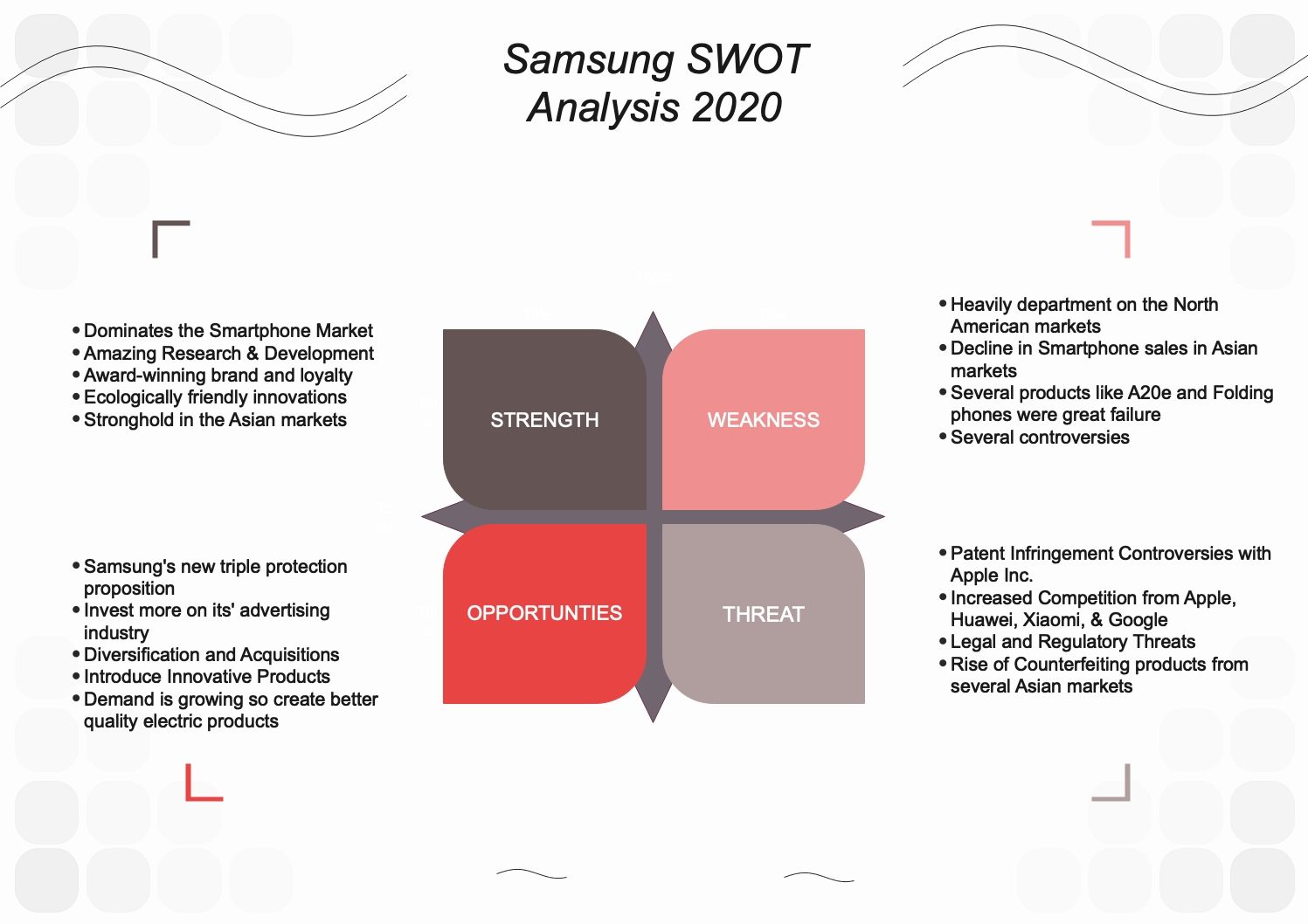Samsung SWOT Analysis
 Source:Tinhte
Source:Tinhte 1.Background of Samsung
1.1. Overall Overview of Samsung
|
Company’s Name |
Samsung |
|
Company’s Former Names |
Samsung electronics |
|
CEO |
Koh Dong Jim, Kim Ki Nim, and Kim Hyun Suk |
|
Company Type |
Private |
|
Year Founded |
1938 |
|
Number of Employees |
287,439 (Dec, 2019) |
|
Annual Revenue |
230 KRW Trillion |
|
Founder |
Lee Byung-Chul |
|
Area Served |
Worldwide |
|
Headquarters |
Samsung city |
|
Operating Income |
KRW 27.77 trillion |
1.2. Introduction to Samsung
Before conducting the Samsung SWOT analysis, one needs to have some knowledge about the company. In the row of Technology Company, Samsung ranks second largest in the world. The company mainly manufactures electronic devices. This company is the conglomerate business of South Korea. The company includes digital television, refrigerators, air conditioner, smartphones, computers, semiconductors, and more such products. According to today’s statistics, the company has operational branches in 79 companies.
1.3. Milestones/ Development Timeline of Samsung
|
1938 |
Lee Byung-Chul opens a grocery and noodles making trading company. |
|
1948 |
Official set up for Samsung Corp., before the expansion of the business. |
|
1950 |
Samsung started to expand onto different areas. |
|
1969 |
Establishment of Samsung Electronics |
|
1977 |
A firm of semiconductor manufacturing is acquired. |
|
1983 |
The company begins to manufacture computers. |
|
1987 |
Lee Byung-Chul expires. Lee Kun-hee, Lee Byung-Chul’s third son, starts working as a group chairman. |
|
1992 |
The company becomes the world’s largest producer of memory chips. |
|
1995 |
Samsung motor begins. Manufacturing of the first liquid crystal display screen. |
|
1997 |
The company has paved the way into the business of mobile phones. |
|
1998 |
Due to the financial crisis in South Korea, Renault buys Samsung Motors at a loss. |
|
2005 |
Samsung outshines Sony |
|
2008 |
Conviction of Lee Kun Hee for tax evasion. |
|
2009 |
A presidential pardon got granted. |
|
2010 |
Lee becomes the chairman again. |
|
2010 |
This year marked the appointment of Jay Y. Lee as one of the presidents of the company. |
2. SWOT analysis of Samsung in details
Samsung SWOT analysis elaborately discusses the strength and weaknesses of the company. The research also figures out the strategies which lead to the expansion or growth of the company. Even this considers the opportunities and threats of the company in the current market situation. Later on, the company utilizes the opportunities and threats to overcome many competitive cases. The SWOT analysis helps to disclose how the company becomes the second largest technology company in the world.
2.1. SWOT analysis of Samsung in detail
Strength:
The Samsung SWOT analysis displays the strength that is helpful in terms of the company's growth.
- The brand has got hold in the marketplace of smartphones. For many years, Samsung is dominating the market. As per Gartner, Samsung occupies a market share of 18.5% where, on the other hand, the market share of Apple is 13.7%.
- Samsung qualifies innovative and fantastic research and development. It has many products in such a competitive ground and has gained a competitive position in their innovative skills. It leads the brand to win many awards; for instance, in 2018, Samsung received 36 CES awards.
- The innovative appliances are ecologically friendly. It has enhanced the reputation of the brand. According to the EPA's 2016 Green Power Partner List, Samsung has ranked in 9th position.
- The company has a stronghold in the Asian Markets, specifically in India and China. The two countries' market places have led to substantial growth, which is advantageous for the company.
Weakness:
Unlike other companies, this brand also fetches several weaknesses, along with its strengths. With the help of analysis, one can quickly identify the weaknesses and flaws, and later on, omits the hindrance.
- Both Apple and Samsung had a sale of 70.8% from the USA market, but Samsung is a firm heavily dependent on the American market, which is an obstacle. It is so because once this market faces any recession, Samsung's sale would have a setback. On the other hand, one should also not forget that Samsung's Asian market presence is also not very good.
- Since 2017, Samsung has experienced a decline in sales of the smartphone.
- Even the brand has delivered some damaged products, which has decreased the confidence of the consumers.
- The company reputation has also experienced many controversial scenarios. For example, in 2015, the firm president went behind bars as he got accused of bribing the government of South Korea for possible merger facilitation. Even though the imprisonment was for just a year, it damaged the firm's reputation so massively that Samsung didn't get a good foothold in the South Korean market until the year 2018.
Opportunities:
Samsung also identifies a few opportunities to expand the business.
- Samsung has introduced the latest air conditioning products, which is known as the 'Triple Protection Proposition' it can give them a favorable advantage in this competitive market.
- The brand needs to capture the Asian and European markets through diversification. Along with diversification, another thing that will help the firm grows its acquisition, especially in the Asian and European markets.
- The brand has come up with new-age innovation and innovative products such as foldable phones, allowing the organization to grow in this stiff competitive market.
- Moreover, the brand equipped a network capacity of 5G and 6G. It again can allow the firm to grow.
Threats:
The company has also faced numerous threats and is still facing them. It is essential to identify them to develop a strategy that will help in the firm’s overall growth and development. Hence, the risks associated with the firm are the following:
- The brand has undergone a patent infringement controversies.
- The competition has increased incessantly from other renowned companies like Apple, Xiaomi, or Huawei.
- Even the brand faces legal and regulatory threats as well. Since law differs from place to place, the company face hindrance in terms of regulations while operating.
- Samsung has counterfeited other brands on the phone. Samsung Galaxy S7 Edge is one of the counterfeited smartphone models.

3. Key Takeaways
Samsung SWOT analysisdisplays specified few weaknesses and strength of the company. From the opportunities and threats also, some recommendations are figured out for the brand:
- The brand should focus on expansion. Hence, they should go for acquisition, and it will help them gain an advantage not only in those markets where they already exist but also in those markets where they have not yet made a mark.
- Along with innovative products, the brand needs to follow a creative means of the advertisement. It encourages retaining the customer's retention.
- Before delivering any product, the company needs to have a quality checking to avoid the delivery of damaged products. It holds the consumer's confidence over the brand.
Use EdrawMax to create a SWOT analysis diagram, or create any other diagram with ease! There are massive SWOT templates and symbols to choose from, and creating a SWOT analysis diagram could be really simple.









